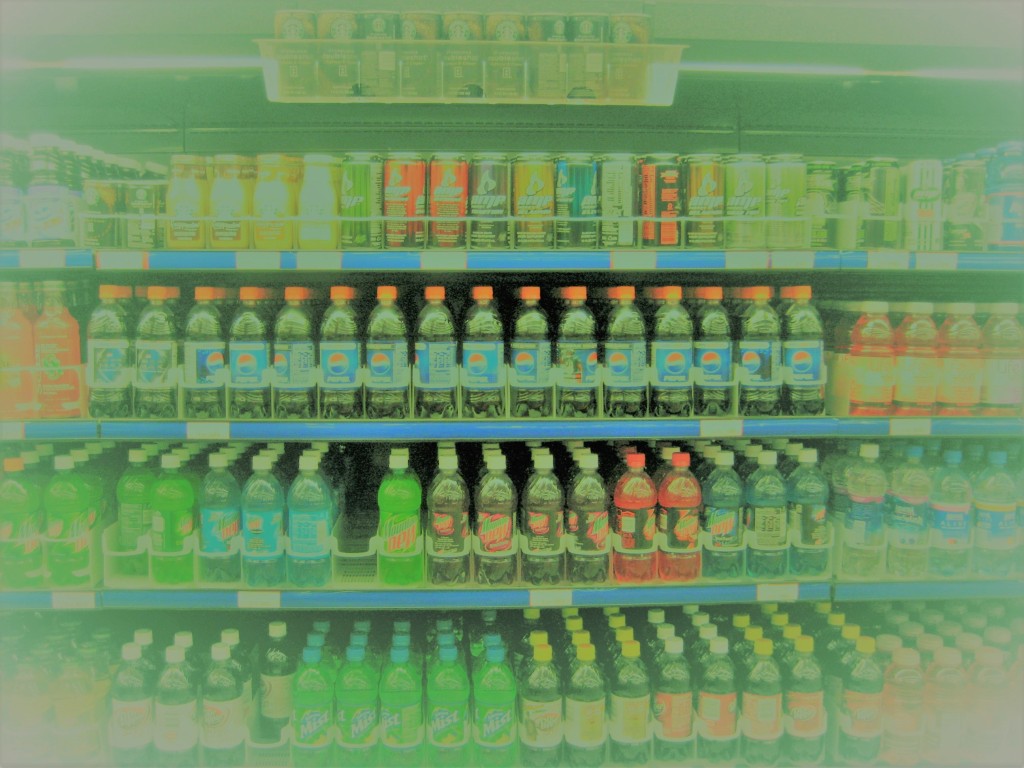
I have a friend who once lost a whole bunch of weight by removing two simple things from his diet. Cheese and soda. This was well before the current Paleo diet craze, when sugary drink taxes weren’t even whispered in the most progressive of city councils. It was also well before I knew anything about the liver or the difference between sucrose and fructose in the sugar I consumed. His story always stuck with me, though I never realized why it had worked.
Ever since the untimely death of my mother from NASH, I have spent a lot of time learning about the underlying causes that likely led to her liver failure. Along the way, I had to reexamine a number of misconceptions and prejudicies I’ve had about health and eating. Whether from genetics or pure luck, I’ve been blessed all my life with never having to worry about weight or what I eat. I never put a lot of thought about what I was putting inside my body until i started to read research about how obesity and metabolic syndrome developed, and why we were suddenly facing a worsening crisis over the last 50 years.
What I’ve found has changed my entire view on food & health.
“The dose makes the poison”
(Please note, there are a lot of truly fantastic source articles and videos linked throughout this post, as I always try to do…but they are really and truly worth taking the time to read and watch as they dive much deeper into the details which are crucial)
Everyone knows that there is “good cholesterol” (HDL) and “bad cholesterol” (LDL). Most people do not realize that there is also good sugar (glucose) and bad sugar (fructose). Really, too much of either kind is bad, but because of the way that glucose is used throughout your body and fructose is only metabolized in the liver, it has an out-sized negative impact. Dr. Robert Lustig puts it plainly…fructose is a poison.
There are a LOT of underlying causes for the obesity epidemic, but one particular factor that has attracted a lot of attention is sugary beverages. There is a really simple, non-medical reason for all of the attention.
This chart:
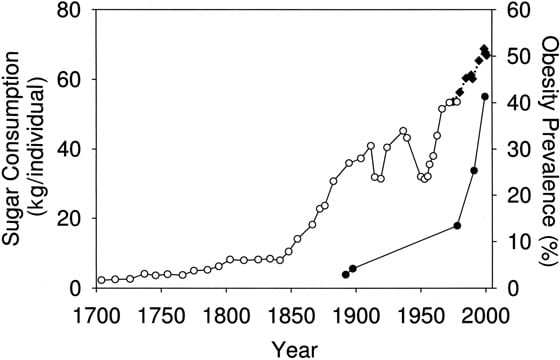
The seeds of modern theories regarding sugar in the diet sprouted from the realization that we as a human race have dramatically increased our consumption of sugar, at a rate greater than the overall increase in total calories over the same time period. The average person in 1900 consumed ~30 grams of sugar per day. In 2000, this amount was ~150 grams…almost 20% of total daily calories!
OK, so what? We’ve increased a lot of things over the last 100 years by large amounts. What makes sugar consumption special?
As Dr. Jason Fung points out in this excellent article, “the dose makes the poison”. 15 grams of fructose might not be a big deal but 75 absolutely is. What’s even worse is that we went from consuming sugars mostly from fruits and other natural foods to predominantly consuming sugar as an additive in nearly every processed food sold in grocery stores. A gram of sugar from an apple is far healthier than a gram of sugar from a soda or a piece of bread.
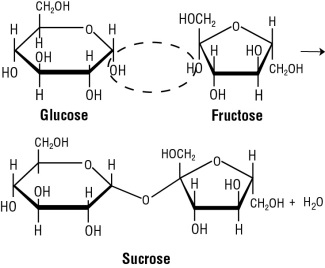
A quick chemistry refresher. Regular table sugar (sucrose) is made up of equal parts of two molecules; glucose and fructose. Glucose is energy for the body. Every cell can metabolize and use it. Glucose stimulates insulin, which regulates your blood sugar. In fact, “blood sugar” is literally the measurement of glucose levels in your blood. Less than a quarter of glucose ingested is processed by the liver; the majority is shipped around your body for energy.
Fructose can’t be used by the body at all. Every gram you ingest is metabolized by your liver. So increasing total sugar consumption gives you a 1 for 1 increase in fructose impacting the liver. Increasing sugar consumption from 30 to 150 grams means your liver processes approximately 15 grams of glucose but 75 of fructose. Provided that we are talking about sucrose.
However, to make things even worse, the type of sugar added to most food products changed in the late 1960s to a particularly unhealthy kind: high-fructose corn syrup.
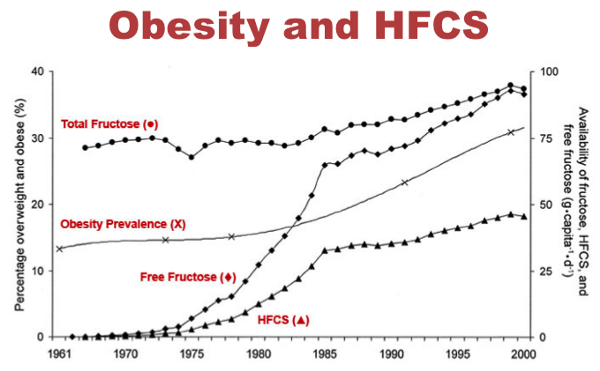
HFCS was cheaper than regular table sugar (sucrose), which meant it quickly became the preferred sweetener for processed food manufacturers. (It also was another outlet for the luicrously rich platform that is corn to monetize.) Unfortunately, it has a higher ratio of fructose to glucose than table sugar does, amplifying the amount of fructose that the liver has to process. As already mentioned, fructose does not have the beneficial qualities that glucose does, and has quite a few harmful traits.
One of the most nefarious things about fructose is that it totally screws up the hunger hormones in the body. These two hormones are ghrelin, which makes you hungry for lunch today, and leptin, which tells your body how hungry to be in the long term. Glucose stimulates insulin which basically sends a message to your bodies cells telling them to take in energy. This has the impact of decreasing ghrelin and increasing leptin. As a result, your hunger is satiated and if all is well-balanced your weight is maintained.
As mentioned, Fructose does not stimulate insulin. Can you see why this is a big deal? Without the normal metabolic processes that glucose puts into motion, the brain doesn’t get the signals that tell it you’ve eaten enough food. So you remain hungry, and you eat more. This problem is magnified exponentially as sugar consumption increases, because long-term sugar overconsumption is strongly linked to Type II Diabetes — insulin resistance — and this in turn leads to leptin resistance. As a result, you need to eat even more food to feel “full”, and the higher levels of leptin prevent your body from burning fat to boot.
If this was the only bad thing fructose did, it would be enough.
Spoiler alert: its not.
the bitter truth
“Fructose is ethanol without the buzz.”
Dr. Robert Lustig
This lecture by Dr. Robert Lustig is full of important statistics and is worth watching in its entirety, but if you don’t have time at least skip to 16:39 and be prepared to have your eyes opened (you can read the full transcript here). Throughout the lecture Lustig provides evidence and research linking fructose to no less than eight metabolic conditions from gout to hypertension and, most importantly for this site’s readers, directly to NASH.
The issue is the way that fructose is broken down (entirely) by the liver. Lustig and others go into great detail of the biochemistry involved but for the purposes of this post I’ll make it as simple as possible. Fructose is processed by the liver and does a bunch of things:
- increases uric acid, which eventually causes gout and chronic increased blood pressure (hypertension)
- overproduces an unlimited amount of glycogen, which is converted to fat (30% of which is stored as fat in the liver, i.e. NAFLD)
- increases liver insulin resistance, which overstimulates pancreas into producing excess insulin leading to type II diabetes
- stimulates an enzyme called JNK 1, which causes inflamation
- provides for addiction-like consumption by interfering with hunger hormones as detailed above
“…hypertension, inflammation, hepatic insulin resistance, hyperinsulinemia, dyslipidemia, muscle insulin resistance, obesity and continued consumption.
Looks like metabolic syndrome to me.”
Dr. Robert Lustig
Lustig uses an apt comparison that is recognizable to most laypeople; alcohol. The long term effects of chronic alcohol use are well documented (and stigmatized, which is a major hurdle advocates for liver disease must overcome). It turns out that fructose shares 8 out of 12 long term health impacts with alcohol. This isn’t a surprise for anyone familiar with NASH, because there are essentially zero differences between non-alcoholic and alcoholic steatohepatitis. Since alcohol and fructose are both essentially sugar, this makes sense.
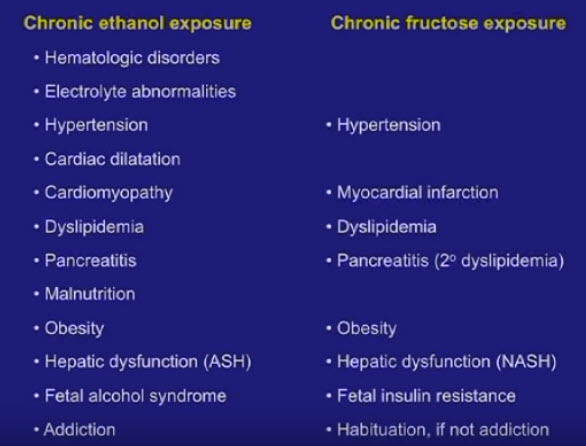
People that drink alcohol in excess on a regular basis end up following the exact same progression of liver disease to steatohepatitis, fibrosis, and cirrhosis that NAFLD/NASH patients experience. Because alcohol and fructose are both toxins. They both come from the same thing. Ethanol is just fermented sugar. It is not surprise that they have similar long-term health impacts.
Fructose is a chronic toxin. Acute fructose exposure did nothing, because the brain doesn’t metabolize fructose. The liver does. And the liver doesn’t get sick after one fructose meal. It gets sick after a thousand fructose meals.
Dr. Robert Lustig
But that’s how many we eat.
a sugar-lite future
The good news is that we don’t have to strive for a completely sugar-free existence; nor should we! A life without occasional sweets or sugars would be a boring one indeed. Simply strive to find ways to reduce overall consumption and be aware of those things that are particularly high in fructose. And even fructose, like so many things that are bad for us in large amounts, can be a good thing in moderation. In fact, fructose does have one quality that works exactly as advertised in a specific product: sports energy drinks.
The second bullet above mentions that fructose overproduces glycogen. Glycogen is like a backup battery reserve of energy that is stored in your liver and can be quickly released when needed. Due to the way that fructose hyper-produces glycogen, it is indeed very useful at replenishing energy when your liver’s reserves have been exhausted after strenuous exercise or at building up excess amounts prior to such events (this is why “carbo-loading” works). As Dr. Lustig succinctly points out, however, the majority of sports drinks are not consumed by elite athletes in these specific circumstances. They are consumed by kids, every day.
As a parent myself, I have come to strongly recognize that sugary beverages are just not something that I want my children to regularly consume. Very (very!) importantly, this includes fruit juice! For quite a long time fruit juice was thought to be healthy for kids but even 100% natural fruit juices are just not healthy on a regular basis. Juice takes the sugar out of the fruit and then throws away all of the fiber and other essential nutrients that it provides. As a result, it ends up acting just like soda or other sugary beverages, providing empty calories that don’t satiate hunger and leading to kids eating more food. And almost 70% of all children ages 2 to 19 have at least one sugary beverage a day.
The easiest way to reduce fructose and overall sugar consumption is just to abandon any normal consumption of such drinks. Having kids just drink water and milk regularly can cut their daily sugar intake in half. Removing fructose from the rest of the diet is harder, because so many food products today include it, even ones you would never expect. Would you ever guess that many baby formulas include high-fructose corn syrup? Not only is the answer yes but there is strong evidence of risk to babies drinking such formulas. Taking the time to look at the labels of most common foods and reducing condiment usage are easy ways to limit fructose exposure.
Luckily the world is starting to wake up to the toxic nature of excess sugar. In addition to things like the sugary beverage taxes, the conversation about sugar is starting to turn more adversarial, with NYC recently launching a campaign comparing sugary drinks to cigarettes. Some people ask if that is going too far.
With the staggering numbers of people currently affected by NAFLD and NASH, there can be no doubt the answer is that it is not far enough.
If this article didn’t scare you enough, check out this amazing info-graphic on US Sugar Consumption.

Hi David,
Another excellent article on the many evils of liver disease. Appreciate the information. Keep up the good work!
LikeLike